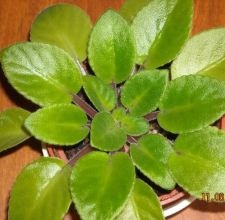What do you think of when you hear the word "groom?" First thoughts might be of a bridegroom, of someone who tends horses, of the process of preparing a dog for show, or of the perfect lawn. Not here! In this article, I’m going to show you when and how you should groom your African violet-not only to make the most of its appearance, but also to promote its good health.
- Difficulty:
- Moderately Easy
Instructions
things you’ll need:
- African violet
- Dry microfiber cloth
- Toothpicks
- When to groom your African violet:
Groom your African violet every time you water it, without fail. Use the link for the first resource listed below to review "How to Water an African Violet."  Gently look underneath healthy leaves for those that are dead or dying.
Gently look underneath healthy leaves for those that are dead or dying.
How to groom your African violet:
The first step in grooming your African violet is to take a good look at it. Do you see any dead or dying leaves and/or blossoms? Remove them so the plant can focus its energy on growth, not on trying to support dying foliage and flowers. Also, dead leaves lying on the soil will encourage rot to develop. Dead leaves or blossoms will pull off without any resistance. Dying leaves may need to be carefully removed with a sharp knife. Larger bits of debris may be seen within the ellipse.
Larger bits of debris may be seen within the ellipse.
Healthy leaves need attention, too. The same types of debris and dust that you remove from the floors and surfaces in your home also fall on your African violet’s leaves. It may be difficult to see, but it’s there.
 Gently wipe off each leaf.
Gently wipe off each leaf.
Support the bottom of each leaf as you gently use a dry microfiber cloth to brush debris from the surface of the leaf to its tip and then onto your hand.
-
Observe the plant’s symmetry: are any leaves out of place? If so, check carefully for suckers, which are small plants that sometimes sprout near the stem or-more difficult to find-near the soil. If the sucker is allowed to grow in place, the plant will become less & less symmetrical. Sometimes this looks like a second African violet growing in the pot, sometimes like a developing second crown. Remove any suckers you find. The longer you wait, the easier it is to find them, but the more detrimental to the plant’s symmetry. Eventually, you will be able to find a sucker when it is still just one leaf, not three or four. Allow only one African violet per pot for best plant development.
-
You may notice one or more leaves out of symmetry, either because of displacement by the now-removed sucker, or because they simply happened to grow that way. To restore symmetry, gradually reposition the leaf: move the leaf very slightly in the direction you want it to grow, and use one or more toothpicks to hold the leaf in its new position. After two or three days, move the leaf a little bit more, and hold the new position with one or two toothpicks. Repeat until the leaf arrives at and is able to maintain, without supports, its proper position to restore the plant’s symmetry.
- Turn the African violet about 90 degrees each time you water it, so that its symmetry isn’t destroyed when the plant reaches for light on one side only. Daily turning is ideal. Use the link for the second resource listed below to read "How to Provide Light for an African Violet."
- Periodically, dust and clean the African violet pot itself, to make sure that the condition of the container will not detract from the African violet’s overall appearance.
Tips & Warnings
-
Groom the African violet each time you water it: regular grooming produces the best results.
-
Dedicate one microfiber cloth for use with your African violets to avoid exposing the plants to unwanted substances.
-
Do not move any leaf further than necessary to inspect for dead leaves and blossoms, or else the stem will break.
-
Reposition a leaf very slowly. If the leaf cannot move easily in the direction you want, be patient! Wait a few more days before advancing the leaf to its next position; otherwise, the symmetry you want will be ruined when the stem breaks.


Deprecated: strpos(): Passing null to parameter #1 ($haystack) of type string is deprecated in /home/agriviek8Qv/agriviet.net/public_html/wp-includes/comment-template.php on line 2522